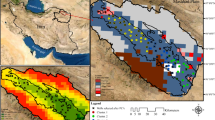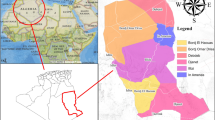Abstract
Settlement of sediments behind weirs and accumulation of materials floating on water behind gates decreases the performance of these structures. Weir-gate is a combination of weir and gate structures which solves them Infirmities. Proposing a circular shape for crest of weirs to improve their performance, investigators have proposed cylindrical shape to improve the performance of weir-gate structure and call it cylindrical weir-gate. In this research, discharge coefficient of weir-gate was predicated using adaptive neuro fuzzy inference systems (ANFIS). To compare the performance of ANFIS with other types of soft computing techniques, multilayer perceptron neural network (MLP) was prepared as well. Results of MLP and ANFIS showed that both models have high ability for modeling and predicting discharge coefficient; however, ANFIS is a bit more accurate. The sensitivity analysis of MLP and ANFIS showed that Froude number of flow at upstream of weir and ratio of gate opening height to the diameter of weir are the most effective parameters on discharge coefficient.
Similar content being viewed by others
References
Dehdar-behbahani S, Parsaie A. Numerical modeling of flow pattern in dam spillway’s guide wall. Case study: Balaroud dam, Iran. Alexandria Engineering Journal, 2016, 55(1): 467–473
Parsaie A, Haghiabi A H, Moradinejad A. CFD modeling of flow pattern in spillway’s approach channel. Sustainable Water Resources Management, 2015, 1(3): 245–251
Budarapu P R, Gracie R, Yang S W, Zhuang X, Rabczuk T. Efficient coarse graining in multiscale modeling of fracture. Theoretical and Applied Fracture Mechanics, 2014, 69: 126–143
Budarapu P R, Yb S S, Javvaji B, Mahapatra D R. Vibration analysis of multi-walled carbon nanotubes embedded in elastic medium. Frontiers of Structural and Civil Engineering, 2014, 8(2): 151–159
Budarapu P R, Javvaji B, Sutrakar V K, Roy Mahapatra D, Zi G, Rabczuk T. Crack propagation in graphene. Journal of Applied Physics, 2015, 118(6): 064307
Budarapu P R, Narayana T S S, Rammohan B, Rabczuk T. Directionality of sound radiation from rectangular panels. Applied Acoustics, 2015, 89: 128–140
Parsaie A, Haghiabi A. The effect of predicting discharge coefficient by neural network on increasing the numerical modeling accuracy of flow over side weir. Water Resources Management, 2015, 29(4): 973–985
Parsaie A, Haghiabi A H. Computational modeling of pollution transmission in rivers. Applied Water Science, 2015, 89: 1–10
Parsaie A, Haghiabi A H. Predicting the longitudinal dispersion coefficient by radial basis function neural network. Modeling Earth Systems and Environment, 2015, 1(4): 1–8
Sudhir Sastry Y B, Budarapu P R, Krishna Y, Devaraj S. Studies on ballistic impact of the composite panels. Theoretical and Applied Fracture Mechanics, 2014, 72: 2–12
SudhirSastry Y B, Budarapu P R, Madhavi N, Krishna Y. Buckling analysis of thin wall stiffened composite panels.” Computational Materials Science, 2015, 96(B): 459–471
Talebi H, Silani M, Bordas S P A, Kerfriden P, Rabczuk T. A computational library for multiscale modeling of material failure. Computational Mechanics, 2013, 53(5): 1047–1071
Talebi H, Silani M, Bordas S P A, Kerfriden P, Rabczuk T. Molecular dynamics/XFEM coupling by a three-dimensional extended bridging domain with applications to dynamic brittle fractures. 2013, 11(6): 527–541
Yang S W, Budarapu, P R, Mahapatra, D R, Bordas S P A, Zi G, Rabczuk T. A meshless adaptive multiscale method for fracture. Computational Materials Science, 2015, (B): 382–395
Amiri F, Millán D, Shen Y, Rabczuk T, Arroyo M. Phase-field modeling of fracture in linear thin shells. Theoretical and Applied Fracture Mechanics, 2014, 69: 102–109
Azamathulla H M, Haghiabi A H, Parsaie A. Prediction of side weir discharge coefficient by support vector machine technique. Water Science and Technology: Water Supply, 2016
Nguyen-Thanh N, Kiendl J, Nguyen-Xuan H, Wüchner R, Bletzinger K U, Bazilevs Y, Rabczuk T. Rotation free isogeometric thin shell analysis using PHT-splines. Computer Methods in Applied Mechanics and Engineering, 2011, 200(47–48): 3410–3424
Parsaie A. Analyzing the distribution of momentum and energy coefficients in compound open channel. Modeling Earth Systems and Environment, 2016, 2(1): 1–5
Rabczuk T, Areias P M A, Belytschko T. A meshfree thin shell method for non-linear dynamic fracture. International Journal for Numerical Methods in Engineering, 2007, 72(5): 524–548
Israelsen O W, Hansen V E. Irrigation Principles and Practices, Wiley, 1962
Negm A, El-Saiad A, Alhamid A, Husain D. Characteristics of simultaneous flow over weir and below inverted V-Notches Civil Engineering Research Magazine (CERM). Civil Engineering Department, Faculty of Engineering, Al-Azhar University, Cairo, Egypt, 1994, 16(9): 786–799
Negm A, El-Saiad A, Saleh O. Characteristics of combined flow over weirs and below submerged gates. In: Proceedings of the Al-Mansoura Eng. 2nd Int. Conf. (MEIC’97). 1997, 1–3
Ferro V. Simultaneous flow over and under a gate. Journal of Irrigation and Drainage Engineering, 2000, 126(3): 190–193
Negm A A M, Al-Brahim A M, Alhamid A A. Combined-free flow over weirs and below gates. Journal of Hydraulic Research, 2002, 40(3): 359–365
Bagheri S, Heidarpour M. Overflow characteristics of circularcrested weirs. Journal of Hydraulic Research, 2010, 48(4): 515–520
Chanson H, Montes J S. Overflow characteristics of circular weirs: effects of inflow conditions. Journal of Irrigation and Drainage Engineering, 1998, 124(3): 152–162
Schmocker L, Halldórsdóttir B R, Hager W H. Effect of weir face angles on circular-crested weir flow. Journal of Hydraulic Engineering, 2011, 137(6): 637–643
Haghiabi A H. Hydraulic characteristics of circular crested weir based on Dressler theory. Biosystems Engineering, 2012, 112(4): 328–334
Kabiri-Samani A, Bagheri S. Discharge coefficient of circularcrested weirs based on a combination of flow around a cylinder and circulation. Journal of Irrigation and Drainage Engineering, 2014, 140(5): 04014010
Mohammadzadeh-Habili J, Heidarpour M, Afzalimehr H. Hydraulic characteristics of a new weir entitled of quarter-circular crested weir. Flow Measurement and Instrumentation, 2013, 33(0): 168–178
Severi A, Masoudian M, Kordi E, Roettcher K. Discharge coefficient of combined-free over-under flow on a cylindrical weir-gate. ISH Journal of Hydraulic Engineering, 2015, 21(1): 42–52
Azamathulla H, Ghani A. Genetic programming for predicting longitudinal dispersion coefficients in streams. Water Resources Management, 2011, 25(6): 1537–1544
Cai Y, Zhu H, Zhuang X. A continuous/discontinuous deformation analysis (CDDA) method based on deformable blocks for fracture modeling. Frontiers of Structural and Civil Engineering, 2013, 7(4): 369–378
Najafzadeh M, Azamathulla H M. Neuro-fuzzy GMDH to predict the scour pile groups due to waves. Journal of Computing in Civil Engineering, 2015, 29(5): 04014068
Najafzadeh M, Etemad-Shahidi A, Lim S Y. Scour prediction in long contractions using ANFIS and SVM. Ocean Engineering, 2016, 111: 128–135
Najafzadeh M, Sattar A A. Neuro-fuzzy GMDH approach to predict longitudinal dispersion in water networks. Water Resources Management, 2015, 29(7): 2205–2219
Najafzadeh M, Tafarojnoruz A. Evaluation of neuro-fuzzy GMDHbased particle swarm optimization to predict longitudinal dispersion coefficient in rivers. Environmental Earth Sciences, 2016, 75(2): 1–12
Parsaie A, Haghiabi A. Predicting the side weir discharge coefficient using the optimized neural network by genetic algorithm. Scientific Journal of Pure and Applied Sciences, 2014, 3(3): 103–112
Parsaie A, Yonesi H A, Najafian S. Predictive modeling of discharge in compound open channel by support vector machine technique. Modeling Earth Systems and Environment, 2015, 1(1–2): 1–6
Zhuang X, Augarde C E, Mathisen K M. Fracture modeling using meshless methods and level sets in 3D: Framework and modeling. International Journal for Numerical Methods in Engineering, 2012, 92(11): 969–998
Zhuang X Y, Huang R Q, Zhu H H, Askes H, Mathisen K. A new and simple locking-free triangular thick plate element using independent shear degrees of freedom. Finite Elements in Analysis and Design, 2013, 75: 1–7
Juma I A, Hussein H H, Al-Sarraj M F. Analysis of hydraulic characteristics for hollow semi-circular weirs using artificial neural networks. Flow Measurement and Instrumentation, 2014, 38: 49–53
Vu-Bac N, Lahmer T, Keitel H, Zhao J, Zhuang X, Rabczuk T. Stochastic predictions of bulk properties of amorphous polyethylene based on molecular dynamics simulations. Mechanics of Materials, 2014, 68: 70–84
Vu-Bac N, Lahmer T, Zhang Y, Zhuang X, Rabczuk T. Stochastic predictions of interfacial characteristic of polymeric nanocomposites (PNCs). Composites. Part B, Engineering, 2014, 59: 80–95
Vu-Bac N, Rafiee R, Zhuang X, Lahmer T, Rabczuk T. Uncertainty quantification for multiscale modeling of polymer nanocomposites with correlated parameters. Composites. Part B, Engineering, 2015, 68: 446–464
Vu-Bac N, Silani M, Lahmer T, Zhuang X, Rabczuk T. A unified framework for stochastic predictions of mechanical properties of polymeric nanocomposites. Computational Materials Science, 2015, 96(B): 520–535
Author information
Authors and Affiliations
Corresponding author
Rights and permissions
About this article
Cite this article
Parsaie, A., Haghiabi, A.H., Saneie, M. et al. Predication of discharge coefficient of cylindrical weir-gate using adaptive neuro fuzzy inference systems (ANFIS). Front. Struct. Civ. Eng. 11, 111–122 (2017). https://doi.org/10.1007/s11709-016-0354-x
Received:
Accepted:
Published:
Issue Date:
DOI: https://doi.org/10.1007/s11709-016-0354-x




